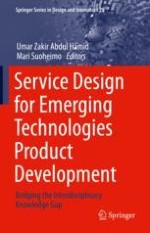The productization of emerging technologies related to the Fourth Industrial Revolution (FIR) is now getting more attention across different industries. Compared to the previous industrial transformations that the world has seen which relied on mechanical innovations, the ongoing FIR is seeing software and data-driven products as the foundation. Apart from that, topics such as circular and sustainable economy as well as climate change are also disrupting the industrial ecosystem. For a viable and successful productization of emerging technologies, collaborations between interdisciplinary stakeholders are a necessity. One of the elements that has been identified to facilitate this collaboration is service design.
This book aimed to provide comprehensive service design discussions for practitioners in different fields and sectors. The aim is to bridge the knowledge gap between experts in academia, business and product development, among many others, to provide a unified understanding of the importance of service design for the productization of emerging technologies. The book consists of an overview of emerging technologies product development and service design, as well as perspectives from different sectors of the industry. The book is expected to benefit multi-disciplinary researchers, practitioners and general audiences with interests in Service Design for Emerging Technologies.
